Technologies
Apple MacBook Air 15-Inch Review: Finally, Big for Less
You don’t need a Pro to get a larger screen size. The Air 15 is the big screen you should go for.
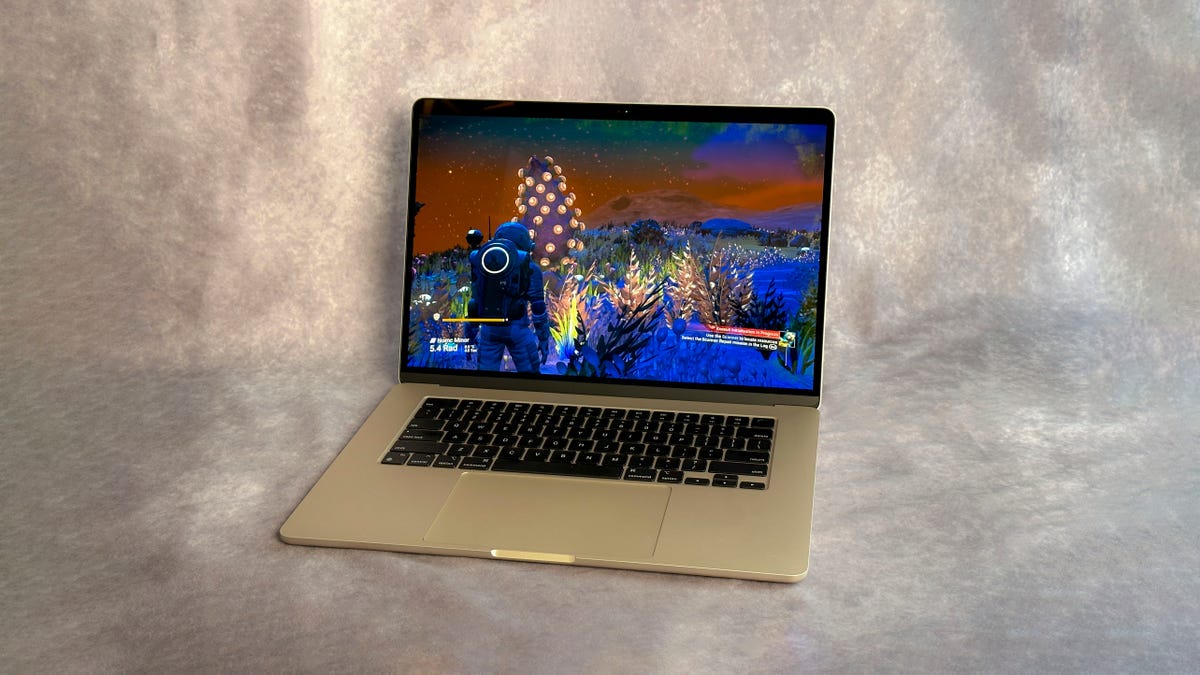
Hello, big screen. When I opened the new MacBook Air 15-inch for the first time, it felt weirdly large. I recently bought the MacBook Air 13-inch M2 model, CNET’s pick for the best laptop overall, and I love it. It’s my do-everything computer, and it has the speed and battery life to handle whatever I take on.
No, I don’t need a MacBook Pro, and you probably don’t either. Apple’s M2 processor in the Air already exceeds the requirements of all but the most serious creative pros. And for the first time it’s now available in a roomy 15-inch laptop.
Putting a larger screen on the thinner, lighter and more affordable Air line is a no-brainer. Apple does this with iPhones, iPads and even to some extent the Apple Watch. It’s the same proposition here: pay a little more, get a bigger screen.
What the 15-inch Air doesn’t do is push the envelope further. A year after the M2 13-inch model, this is basically the same computer with a few tweaks. There’s a default 10-core GPU on the M2, which is an upgrade on the 13-inch version. There are better speakers (or at least more of them). And of course, more screen space and pixels.

06:34

Apple MacBook Air (15-inch)
Like
- Big 15.3-inch screen size
- M2 processor still feels fast
- Costs far less than the Pro laptops
Don’t like
- Very few ports for its size
- No performance boost from the 2022 13-inch Air
But the screen tech is the same (good, but not mini-LED like the Pro models), configurations are largely similar, and most notably, there are no extra ports on the Air’s larger body. That’s the biggest bummer here: two Thunderbolt USB-C type ports, a MagSafe charger and a headphone jack feels even more minimal on this long-edged machine. Why not one more port on the other side, at least? Or two?
The 15-inch Air starts at $1,299 compared with $1,099 for the 13-inch; a $200 uptick is exactly the price bump I’d expect. This whole package is way, way less expensive than the MacBook Pro equivalents. If I were buying a larger-screened Mac laptop, I’d start here first every time. But serious 4K video editors and graphics pros will likely find the Pro worth it if they can afford it.
I wrote this review on the 15-inch Air. I appreciate the extra screen space, and it’s great to have on my desk. But I don’t regret getting the 13-inch version, either.
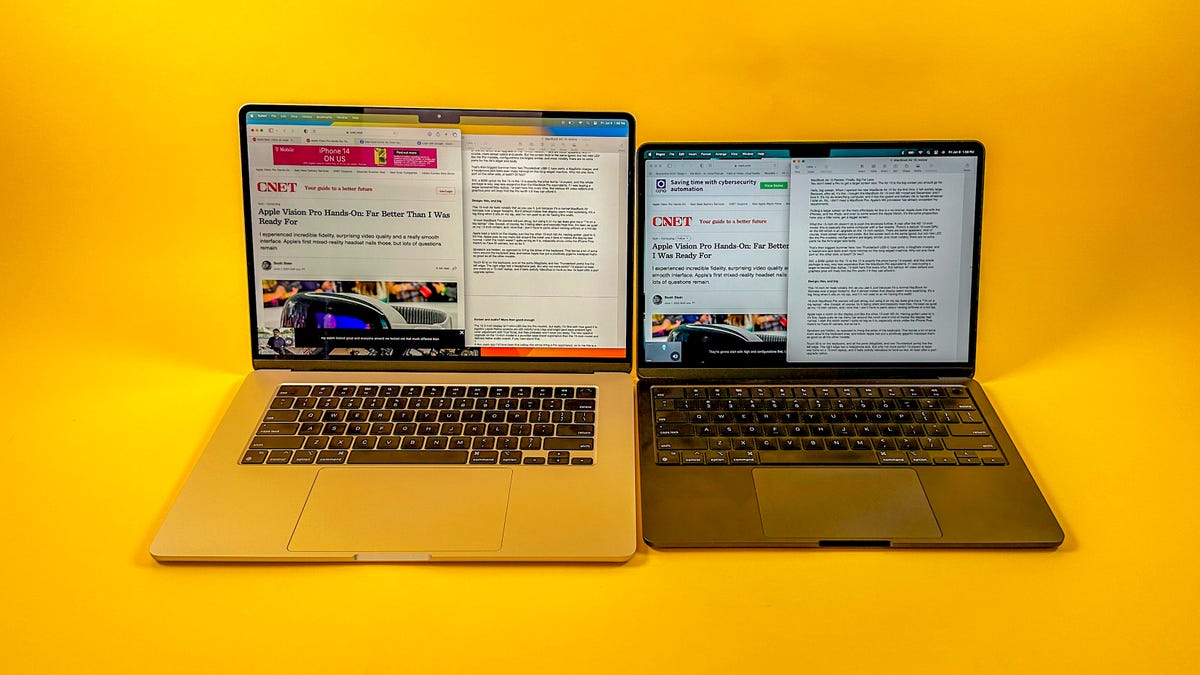
The Air 15 (left) next to the Air 13. Definitely bigger, but the same thickness.
Design: Thin and big
This 15-inch Air feels notably thin as you use it, just because it’s a normal MacBook Air thinness over a larger footprint. But it almost makes that display seem more surprising. It’s a big thing when it sits on my lap, and I’m not used to an Air having this width.
Owners of a 16-inch MacBook Pro will just shrug, but using it on my lap does give me a «I’m on a big laptop» vibe. Except, of course, for it being silent because of its fanless design, and basically heat-free. It’s been as quiet as my 13-inch version, and I love that I don’t have to panic about venting airflows or a hot lap.

The 1080p camera is perfectly fine, just like it was on the 13-inch model. It looks good on Zooms.
Apple kept a camera notch on the display, just like the 13-inch M2 Air. I’m used to it. It’s fine. Apple puts its top menu bar around the notch and it kind of makes the display feel normal. I wish the notch weren’t quite so big as it is, especially since, unlike the iPhone Pros, there’s no Face ID camera, but so be it.
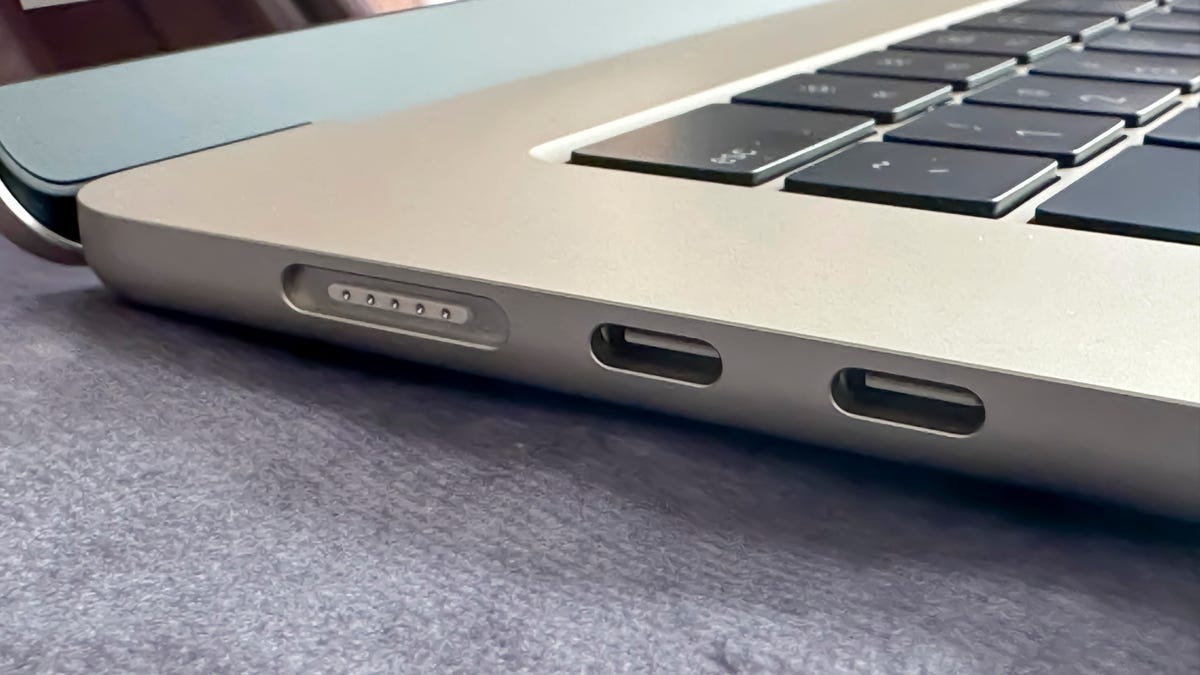
These are the only ports you get, other than a headphone jack. Same as on the 13-inch model.
Speakers are hidden, as opposed to lining the sides of the keyboard. That leaves a lot of extra room around the keyboard area, and below Apple has put a positively gigantic trackpad that’s as good as all the other models.
Touch ID is on the keyboard, and all the ports (MagSafe, and two Thunderbolt ports) line the left edge. The right edge has a headphone jack. But why not more ports? I’d expect at least one more on a 15-inch laptop, and it feels awfully ridiculous to have so few. At least offer a port upgrade option.
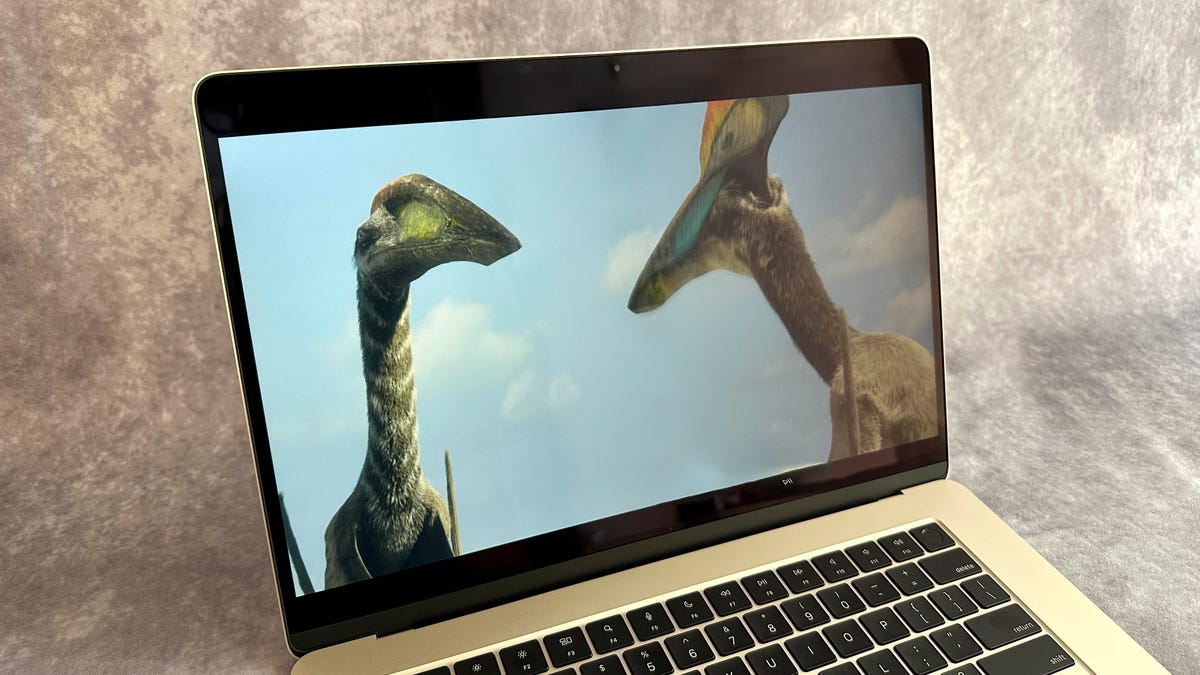
This isn’t mini LED, but it’s perfectly fine for movies and games.
Screen and audio? More than good enough
The 15.3-inch display isn’t mini-LED like the Pro models, but really, I’m fine with how good it is. Apple’s Liquid Retina screens are still colorful and crisp and bright (and have ambient light color adjustment with True Tone), but they probably won’t blow you away. The new speaker upgrade on the 15-inch model is a punchier bass boost experience than the 13-inch model and delivers better audio overall, if you care about that.
A few years ago I’d have called this whole thing a Pro experience, so to me this is a pretty nice Air package overall.

I still like how bag-friendly the 13-inch one is.
Price equation: Worth getting the 15 if you’re spending up for extras
It turns out that the step-up 8GB RAM/512GB storage version of the 15-inch Air is $1,499, while the 13-inch Air’s equivalent is $1,399. Only spending an extra $100 for the larger screen seems like a logical bet for anyone wanting more room to work or something easier on the eyes.
The price gap is $200 for the base model, which also isn’t huge, but I do prefer the 13-inch Air for its portability. I love its compact lap feel and good-enough screen size for my needs. But, putting it next to the 15-inch Air, it’s clear that you can put apps side-by-side more easily on the 15-inch model. My wife looked at both on a table and said she’d prefer the 15 if she were at a desk a lot doing work.

But either way, these laptops are over $1,000 less than the 16-inch-screen MacBook Pro. These are the easiest way to get a great larger-screened MacBook now, and they’re worth it. One note: the 15 now has a year-old M2 processor. Apple’s M2 was only a moderate increase in performance over the breakthrough advance of the M1 before it when it arrived last summer. Will a future M3 take another leap? Maybe you shouldn’t worry. Apple’s speed gains on the M-series chips over the Intel models have been so good that they still feel fantastic.
MacBook Air 15 or 13? Take your pick, either’s fine. At this point in 2023, these MacBook Airs feel like the safest bet in Apple’s laptop lineup.
Technologies
Stay Informed About Your Flights This Holiday Season With Your iPhone’s Tracker
Your iPhone is hiding a flight tracker. Here’s how it works.
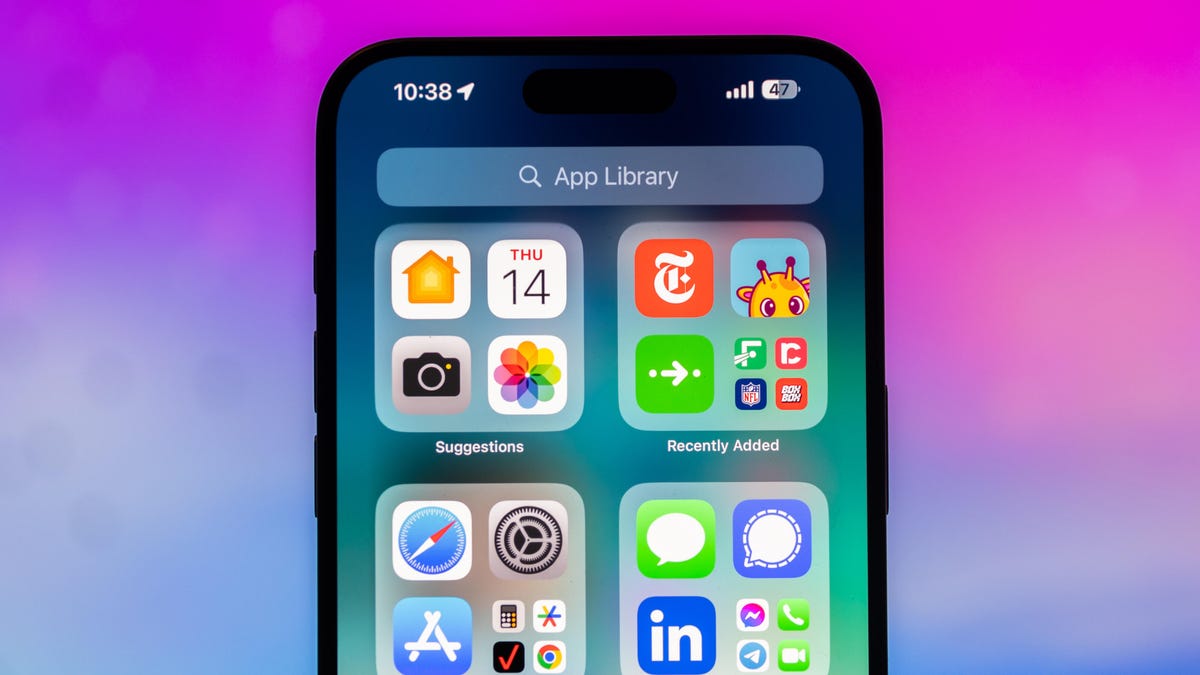
Thanksgiving is only a few short weeks away and if you plan on flying during the holiday season, keeping up-to-date on changes to your flights is crucial. Airports can be hectic during any holiday, but with the government shutdown continuing, flights are liable to change or be cancelled more often.
Luckily, it’s never been easier to get up-to-date information about your flight. For starters, your airline probably has an app, and if not, you can check its website. If you’re in a hurry, you can Google the flight number. Or you can just use your iPhone’s built-in flight tracker that’s sneakily tucked away.
That’s right: Your iPhone has a flight tracker that you may have never known about. It’s there for when it’s needed. Below, we’ll show you have to access it in not one, but two places, so you never have to go hunting for your flight info elsewhere again.
Don’t miss any of our unbiased tech content and lab-based reviews. Add CNET as a preferred Google source on Chrome.
For more on the iPhone, check out everything Apple announced at WWDC 2025.
How to track your flight via iMessage
Before we start, there are a few prerequisites you must meet:
- Make sure iMessage is enabled (it doesn’t work with SMS/MMS).
- You’ll need your flight number somewhere in your text messages, whether you’ve sent that information to someone (even yourself) or it’s been sent to you.
- The flight number must be sent in this format: [Airline] [Flight number], for example, American Airlines 9707.
Launch the native Messages app on your iPhone and open the text message thread that contains your flight information. You’ll know the flight tracker feature works when the text with the flight information appears underlined, which means it’s actionable and you can tap on it.
If your flight is still several months away or it’s already passed, you might see a message that says, «Flight information unavailable.» You might also see another flight that’s not yours because airlines recycle flight numbers.
You can check your flight status from Spotlight Search, too
If getting your flight information from Messages wasn’t easy enough, you can also grab the details right from your iPhone’s home screen by swiping down and adding your flight number into Spotlight Search. Even better, this works with Spotlight Search on your Mac computer, too.
How to access the hidden flight tracker
Although the airline name/flight number format highlighted above is the best way to go, there are other texting options that will lead you to the same result. So let’s say we stick with American Airlines 9707, other options that may bring up the flight tracker include:
- AmericanAirlines9707 (no spaces)
- AmericanAirlines 9707 (only one space)
- AA9707 (airline name is abbreviated and no space)
- AA 9707 (abbreviated and space)
I would suggest you keep the airline name spelled out completely and add a space between the two pieces of information — like in the previous section — because for some airlines, these alternative options may not work.
Real-time flight tracking
Once everything is set, tap on the flight information in your text messages. If the feature works correctly, you should see the following two options appear in a quick-action menu:
- Preview Flight: View the flight’s details. Tap this to view more information about the flight.
- Copy Flight Code: Copy the flight code to your clipboard (in case you want to send your flight details to someone else via text or email).
If you select Preview Flight, at the top of the window, you’ll see the best part of this feature: a real-time flight tracker map. A line will connect the two destinations, and a tiny airplane will move between them, indicating where the flight is at that exact moment.
Underneath the map, you’ll see important flight information:
- Airline name and flight number
- Flight status (arriving on time, delayed, canceled, etc.)
- Terminal and gate numbers (for arrival and departure)
- Arrival and departure time
- Flight duration
- Baggage claim (the number of the baggage carousel)
If you swipe left on the bottom half of the flight tracker, you can switch between flights, but only if there’s a return flight.
For more travel tips, don’t miss our test on whether AI can help you fly more sustainably.
Technologies
How to Get Verizon’s New Internet Plan for Just $25 Per Month
Technologies
This $20K Humanoid Robot Promises to Tidy Your Home. But There Are Strings Attached
The new Neo robot from 1X is designed to do chores. It’ll need help from you — and from folks behind the curtain.

It stands 5 feet, 6 inches tall, weighs about as much as a golden retriever and costs near the price of a brand-new budget car.
This is Neo, the humanoid robot. It’s billed as a personal assistant you can talk to and eventually rely on to take care of everyday tasks, such as loading the dishwasher and folding laundry.
Neo doesn’t work cheap. It’ll cost you $20,000. And even then, you’ll still have to train this new home bot, and possibly need a remote assist as well.
If that sounds enticing, preorders are now open (for a mere $200 down). You’ll be signing up as an early adopter for what Neo’s maker, a California-based company called 1X, is calling a «consumer-ready humanoid.» That’s opposed to other humanoids under development from the likes of Tesla and Figure, which are, for the moment at least, more focused on factory environments.
Neo is a whole order of magnitude different from robot vacuums like those from Roomba, Eufy and Ecovacs, and embodies a long-running sci-fi fantasy of robot maids and butlers doing chores and picking up after us. If this is the future, read on for more of what’s in store.
Don’t miss any of our unbiased tech content and lab-based reviews. Add CNET as a preferred Google source.
What the Neo robot can do around the house
The pitch from 1X is that Neo can do all manner of household chores: fold laundry, run a vacuum, tidy shelves, bring in the groceries. It can open doors, climb stairs and even act as a home entertainment system.
Neo appears to move smoothly, with a soft, almost human-like gait, thanks to 1X’s tendon-driven motor system that gives it gentle motion and impressive strength. The company says it can lift up to 154 pounds and carry 55 pounds, but it is quieter than a refrigerator. It’s covered in soft materials and neutral colors, making it look less intimidating than metallic prototypes from other companies.
The company says Neo has a 4-hour runtime. Its hands are IP68-rated, meaning they’re submersible in water. It can connect via Wi-Fi, Bluetooth and 5G. For conversation, it has a built-in LLM, the same sort of AI technology that powers ChatGPT and Gemini.
The primary way to control the Neo robot will be by speaking to it, just as if it were a person in your home.
Still, Neo’s usefulness today depends heavily on how you define useful. The Wall Street Journal’s Joanna Stern got an up-close look at Neo at 1X’s headquarters and found that, at least for now, it’s largely teleoperated, meaning a human often operates it remotely using a virtual-reality headset and controllers.
«I didn’t see Neo do anything autonomously, although the company did share a video of Neo opening a door on its own,» Stern wrote last week.
1X CEO Bernt Børnich told her that Neo will do most things autonomously in 2026, though he also acknowledged that the quality «may lag at first.»
The company’s FAQ says that for any chore request Neo doesn’t know how to accomplish, «you can schedule a 1X Expert to guide it» to help the robot «learn while getting the job done.»
What you need to know about Neo and privacy
Part of what early adopters are signing up for is to let Neo learn from their environment so that future versions can operate more independently.
That learning process raises privacy and trust questions. The robot uses a mix of visual, audio and contextual intelligence — meaning it can see, hear and remember interactions with users throughout their homes.
«If you buy this product, it is because you’re OK with that social contract,» Børnich told the Journal. «It’s less about Neo instantly doing your chores and more about you helping Neo learn to do them safely and effectively.»
Neo’s reliance on human operation behind the scenes prompted a response from John Carmack, a computer industry luminary known for his work with VR systems and the lead programmer of classic video games including Doom and Quake.
«Companies selling the dream of autonomous household humanoid robots today would be better off embracing reality and selling ‘remote operated household help’,» he wrote in a post on the X social network (formerly Twitter) on Monday.
1X says it’s taking steps to protect your privacy: Neo listens only when it recognizes it’s being addressed, and its cameras will blur out humans. You can restrict Neo from entering or viewing specific areas of your home, and the robot will never be teleoperated without owner approval, the company says.
But inviting an AI-equipped humanoid to observe your home life isn’t a small step.
The first units will ship to customers in the US in 2026. There is a $499 monthly subscription alternative to the $20,000 full-purchase price, though that will be available at an unspecified later date. A broader international rollout is promised for 2027.
Neo’s got a long road ahead of it to live up to the expectations set by Rosie the Robot in The Jetsons way back when. But this is no Hanna-Barbera cartoon. What we’re seeing now is a much more tangible harbinger of change.
-

 Technologies3 года ago
Technologies3 года agoTech Companies Need to Be Held Accountable for Security, Experts Say
-

 Technologies3 года ago
Technologies3 года agoBest Handheld Game Console in 2023
-

 Technologies3 года ago
Technologies3 года agoTighten Up Your VR Game With the Best Head Straps for Quest 2
-

 Technologies4 года ago
Technologies4 года agoVerum, Wickr and Threema: next generation secured messengers
-

 Technologies4 года ago
Technologies4 года agoBlack Friday 2021: The best deals on TVs, headphones, kitchenware, and more
-

 Technologies4 года ago
Technologies4 года agoGoogle to require vaccinations as Silicon Valley rethinks return-to-office policies
-

 Technologies4 года ago
Technologies4 года agoOlivia Harlan Dekker for Verum Messenger
-

 Technologies4 года ago
Technologies4 года agoiPhone 13 event: How to watch Apple’s big announcement tomorrow
